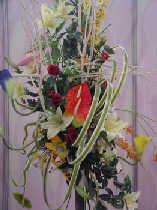 Mass Bouquets. Mass bouquets bring color and life into a room. Peonies, asters, lilacs, larkspurs, and chrysanthemums are only a few of the flowers used in such arrangements. These bouquets may consist of one variety of a blossom with its own leaves, buds and seed pods, or they may include several harmonious varieties. In a composite bouquet, one kind of flower should dominate in terms of quantity, attractiveness and, usually, in size, while another kind should be very inconspicuous. All types of flowers should be decidedly different in form, size, and texture.
Mass Bouquets. Mass bouquets bring color and life into a room. Peonies, asters, lilacs, larkspurs, and chrysanthemums are only a few of the flowers used in such arrangements. These bouquets may consist of one variety of a blossom with its own leaves, buds and seed pods, or they may include several harmonious varieties. In a composite bouquet, one kind of flower should dominate in terms of quantity, attractiveness and, usually, in size, while another kind should be very inconspicuous. All types of flowers should be decidedly different in form, size, and texture.
Platter Bouquet. The platter bouquet is a more unusual and more complex composition of flowers than line or mass arrangements. The stemless blossoms of dahlias or zinnias look great when afloat in water with a few leaves in a flat bowl. Less important flowers of other varieties may also accompany them.
Geometric Bouquet. The geometric bouquet is the opposite of the natural bouquet. Here, flowers are placed in a stylistic, orderly design, which is particularly suitable for modern rooms with geometric forms. Usually, vases for such arrangements are simple geometric shapes that determine the lines of the entire bouquet. Variety in flower form, color and texture adds individuality to a geometric arrangement. One unusual semigeometric bouquet consists of a tall phlox stalk with a smalltigerlily and a cluster of geranium blossoms of vermilion and magenta on each side, with the red-violet stock hiding the stems set in a wire stem holder in a flat, green dish. Throughout the bouquet are many long stems with downy soft green seed pods that unify the arrangement.
Uncut Flower Arrangements. Flower lovers who do not like to cut flowers can make pleasing arrangements by combining potted plants. Bulbs and foliage plants look very attractive in a single container and cactus plants of various shapes also make interesting combinations. The possibilities for imaginative expressions in this kind of plant arrangement are endless.
Color. In arranging flowers, color is even more important to consider than form. The best way to get a quick and effective bouquet is to have a single color sequence, such as violet with red-violet and blue-violet, or a more brilliant harmony of yellow with yellow-orange and yellow-green, or red, red-orange and red-violet. It is best to decide on the type of bouquet one desires: "warm" (red, pink, etc) or "cool" (blue, green, etc.)